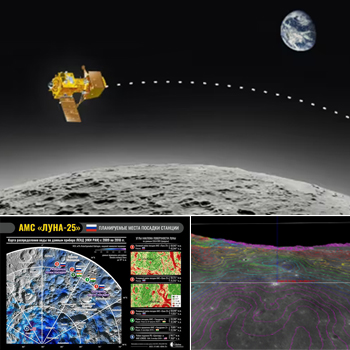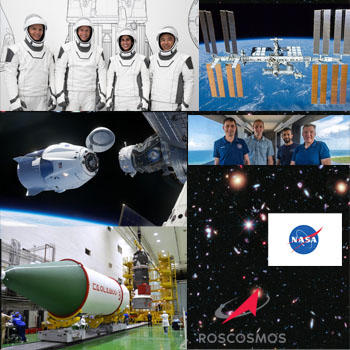India, Russia and Japan Craft Prepare to Join China Landers Operating on Moon
|
MONDAY☆ Aug 21 — International Space Station, ~415-km LEO: Expedition 69 seven-member crew working with space manufacturing study, maintaining spacesuits, transferring cargo from Progress 84P, preparing for Progress 85P docking. ☆ Aug 21 — Tiangong Space Station, ~390-km LEO: Shenzhou 16 three-member crew now ~1/2 through mission, continuing station upgrades, conducting fluid mechanics experiments; Heavens Above offers visible pass tracking. Highlights… o NewSpace: Intuitive Machines announces NET Nov 15 launch to Moon following Sep 15 Nova-C shipment to Florida; Rocket Lab to launch two 6U CubeSats for NASA / UW-Madison PREFIRE arctic monitoring mission; Rivada Space to pay Terran Orbital US$180M on $2.4B / 300-satellite contract. ☆ Solar System: New Horizons PI Alan Stern discusses mission objective concerns while craft at 56.75 AU from Sun plans Uranus & Neptune observations in Fall; Solar Cycle 25 already exceeding sunspot activity projected peak as 2025 climax approaches. ☆ Galaxy: Astronomers working to analyze data from JWST NIRSpec to characterize composition of furthest known star ‘Earendel’, formed <1 billion years after Big Bang; Jupiter-like exoplanet 1,400 ly distant, ~2,000°C hotter than Sol characterized with VLT aiding understanding of binary system evolution; Euclid preparing for further tests & 6-year planned operations after joining Gaia and JWST at L2. o Global: NASA projects peak El Niño effects in February, March, April 2024 following hottest July since 1880; IAA astrophysicist Jayant Murthy urges India regulators to allow Spectroscopic Investigations of Nebular Gas to be exported for mounting on Tiangong Space Station; Aditya-L1 solar observatory being prepared for PSLV launch. ● USA: Mars Ascent Vehicle propulsion undergoing testing at MSFC ahead of sample return mission NET 2030; FAA reviewing final mishap report on Starship test explosion, next Integrated Flight Test 2 may launch NET Aug 31; DARPA soliciting commercial proposals to offer monetizable lunar services by 2035 under LunA-10. ● Hawai’i: Hawaii Community Foundation, Maui Rapid Response & Aloha United Way collecting aid for residents affected by deadly fires in Lāhainā, Maui as refugees struggle to persevere with little federal assistance; Goddard Institute for Space Studies Director Gavin Schmidt suggests invasive grasses, derelict plantations, and anthropocentric climate change contributed to fires; NASA pan IfA grad student research on comets and black holes to be supported by NASA Earth and Space Science and Technology grants. |
 |
● = Terrestrial and… o = International terrestrial events
☾ = Moon activity ★ = Space and… ☆ = International space / astro events in Hawaii Standard Time unless noted. Add 10 hours to obtain UT (‘Universal Time’). |
Weekly Planet Watch – Evening Planets: Saturn (ESE), Uranus (E), Neptune (E); Morning Planets: Venus (E), Jupiter (S).
ISS: Humans Continuously in Space; SpaceX and Soyuz Launches
In space human activity continues as SpaceX Crew 6 with Andrey Fedyaev, Woody Hoburg, Stephen Bowen and Sultan Alneday prepare to leave ISS at the end of August after a 6-month mission, conducting over 200 experiments to help prepare for future missions to Moon, Mars and beyond. Crew 7 is scheduled to launch no earlier than 02:45 EDT August 25 with international Astronauts Jasmin Moghbeli (NASA), Andreas Mogensen (ESA), Satoshi Furukawa (JAXA), Konstantin Borisov, (Roscosmos) for a 6-month mission, the 11th overall crewed orbital flight. They are scheduled to dock to the orbiting laboratory about 03:49 EDT Aug 26, to the space-facing port of the Harmony module. SpaceX Crew Dragon Endurance Spacecraft marks the eighth human spaceflight mission supported by a SpaceX Dragon spacecraft and the seventh crew rotation mission to the space station since 2020 for NASA. Russia also plans Aug 23 launch of resupply mission Soyuz 85th Progress cargo delivery ship to ISS. It is preceded by successful launch in May of Progress 84 resupply cargo freighter carrying about 2,500 kg of supplies including experiments, fuel and food to support crew of Expedition 69. ISS has been continuously occupied since November 2000 with Astronauts testing technologies, conducting science experiments, developing skills needed to operate future commercial destinations in low-Earth orbit for the benefit of all. (Image Credits: NASA, SpaceX, Roscosmos) |
★ NET Aug 21 — SpaceX, Launch Falcon 9 / Starlink 7-1, SLC-4E, Vandenberg SFB CA: Falcon 9 to carry second generation Starlink V2 Mini internet satellites; Falcon first stage to land on ‘Of Course I Still Love You’ drone ship in Pacific. ● Aug 21 — Celestis, Online: Facebook Live: Updates on ULA Cert 1 flight for Vulcan Centaur; with ULA President Tony Bruno, 15:00 CDT. ★ Aug 21 — Parker Solar Probe, Heliocentric Orbit: Spacecraft to perform 6th flyby of Venus today. ● Aug 21-25 — NASA, KnowInnovation (KI), Greenbelt MD: Astrobiology Mission Ideation Factory: The Search for Life on Mars. ☆ Aug 21 — Moon: 2.27° NE of Spica, 03:00. ☆ Aug 21 — Apollo Asteroid 2023 PM1: Near-Earth Flyby (0.020 AU). Continued From… o Jun 26 – Aug 25 — International Space University (ISU), National Institute for Space Research (INPE), Aeronautics Institute of Technology (ITA), et al, São José dos Campos, Brazil: 35th ISU Space Studies Program (SSP 2023). TUESDAY☆ Aug 22 — Roscosmos, Launch Soyuz-2.1a / Progress 85P, Baikonur Cosmodrome, Kazakhstan: Soyuz rocket to launch 85th Progress cargo delivery ship to ISS; live coverage available. ☆ Aug 22 — Amor Asteroid 2023 PM: Near-Earth Flyby (0.024 AU). WEDNESDAY☾ NET Aug 23 — Chandrayaan-3, Lunar Landing: India Chandrayaan-3 lander and rover to attempt Moon South Pole region landing site near Manzinus U (69.368°S, 32.348°E) ~17:47 IST; second landing window in September. ☆ NET Aug 23 — Rocket Lab, Launch Electron/ ‘We Love the Nightlife’, Mahia Penninsula, New Zealand: First four of Capella Space next-generation Synthetic Aperture Radar (SAR) Earth-imaging satellites “Acadia” with 200-300 kg payload. ☆ Aug 23 — NASA, Online: Pre-Departure Interviews With Crew-6 Aboard ISS; 02:40 EDT. ☆ Aug 23 — Moon: At first quarter, 23:57. ☆ Aug 23 — Apollo Asteroid 6037 1988 EG: Near-Earth Flyby (0.040 AU). THURSDAY☆ Aug 24 — International Space Station, Progress 85P Rendezvous, ~415-km LEO: Roscosmos Progress 85P cargo ship to rendezvous and dock at ISS; live coverage available. |
● Aug 24 — Arizona State University, Tempe AZ: Space Futures Live; featuring Phil Metzger, Shannon Curry, MJ Rubenstein, Christopher Johnson, Hiro Ono, Jacques Arnould, Lisa Ruth Rand; 13:30-17:00.
☆ Aug 24 — Moon: 1.07° NNE of Antares, 17:00.
FRIDAY
★ Aug 25 — Voyager 1, Interstellar Space: NASA spacecraft begins 12th year in interstellar space, data indicates it became first human-made object to enter interstellar space Aug 25, 2012; launched Sep 5, 1977.
★ Aug 25 — SpaceX, Launch Falcon 9 / Crew 7, LC-39A, Kennedy Space Center FL: Falcon 9 to launch at 03:49 EDT Crew Dragon with Astronauts Jasmin Moghbeli (NASA), Andreas Mogensen (ESA), Satoshi Furukawa (JAXA) and Konstantin Borisov (Roscosmos) to ISS for six-month expedition; Falcon 9 first stage booster to land on drone ship in Atlantic Ocean.
SATURDAY
☆ Aug 26 — JAXA, Launch H-2A / Smart Lander for Investigating Moon (SLIM) and X-Ray Imaging and Spectroscopy Mission (XRISM), Tanegashima Space Center, Japan: SLIM Moon mission project date to launch (09:34:57 JST) to small crater in Mare Nectaris on Moon near side equatorial region, with X-Ray Imaging and Spectroscopy Mission (XRISM) for studying galactic plasma; will test technologies for future lunar missions; launch window extends through Sep 15.
● Aug 26 — Ad Astra Kansas Foundation, Space Age Publishing Company, Hutchinson KS: 15th Annual Ad Astra Galaxy Forum: Asteroids, EXO-planets & More; at the Cosmosphere and livestreamed on Facebook, 13:00-15:00.
o Aug 26-27 — Aix-Marseille University, Marseille Astrophysics Laboratory, CNES, ESA, et al, Marseille, France: 20th International Planetary Probe Workshop Short Course: In Situ Exploration of the Solar System: Science Cases & Instrumentation.
o Aug 26 – Sep 1 — Stardust Alliance, Timmins, Ontario, Canada: 2023 Stardust Festival; connecting indigenous communities and aerospace-focused STEM.
SUNDAY
☆ Aug 27 — BlueWalker 3 Visible Pass, ~415-km LEO: BlueWalker 3 satellite (AST SpaceMobile prototype satellite) to make visible pass over Hawai’i Islands from NW to SSE starting 19:59:56 HST, brightest magnitude 2.3.
 China will reach 10 years of continuous activity on the lunar surface December 14, and Chang’E-3/4 should finally have company at that time. ISRO Chandrayaan-3, now separated from propulsion module, is zeroing in on landing site ~20 km west of Manzinus U crater (69.368°S, 32.348°E). ISRO operators work to finish landing system firing tests from 153 x 163 km polar orbit ahead of 2 deorbiting maneuvers which will bring Chandrayaan-3 into an elliptical 30 x 100 km landing orbit. If all goes as anticipated, touchdown to occur NET August 23 at 12:17 UTC. Science instruments on Vikram lander which will be utilized over the 1-lunar day nominal mission (14-Earth days) include plasma density sensor RAMBHA, ChaSTE thermal sensor, ILSA seismometer, and a passive retroreflector array supplied by NASA, while Pragyan rover carries an X-ray spectrometer and a laser spectroscope. Roscosmos Luna-25 may already be in the vicinity when Chandrayaan-3 lands, having achieved lunar orbit insertion Aug 16 and targeting landing at 69.545°S, 43.544°E, ~50 km northeast of Boguslawsky crater NET Aug 21, 23:10 UTC. Luna-25 carries 8 instruments including STS-L panoramic / local imager, ARIES-L plasma sensor, LASMA-LR mass spectrometer, LIS-TV-RPM infrared spectrometer and a retroreflector. Not to be left out, Japan is also launching Smart Lander for Investigating Moon (SLIM) with Lunar Excursion Vehicle 2 rover to a site ~500 m east of Shioli crater (13.33°S, 25.23°E) NET Aug 26, aiming to achieve 100-m landing accuracy. (Image Credits: ISRO, Roscosmos, JAXA)
China will reach 10 years of continuous activity on the lunar surface December 14, and Chang’E-3/4 should finally have company at that time. ISRO Chandrayaan-3, now separated from propulsion module, is zeroing in on landing site ~20 km west of Manzinus U crater (69.368°S, 32.348°E). ISRO operators work to finish landing system firing tests from 153 x 163 km polar orbit ahead of 2 deorbiting maneuvers which will bring Chandrayaan-3 into an elliptical 30 x 100 km landing orbit. If all goes as anticipated, touchdown to occur NET August 23 at 12:17 UTC. Science instruments on Vikram lander which will be utilized over the 1-lunar day nominal mission (14-Earth days) include plasma density sensor RAMBHA, ChaSTE thermal sensor, ILSA seismometer, and a passive retroreflector array supplied by NASA, while Pragyan rover carries an X-ray spectrometer and a laser spectroscope. Roscosmos Luna-25 may already be in the vicinity when Chandrayaan-3 lands, having achieved lunar orbit insertion Aug 16 and targeting landing at 69.545°S, 43.544°E, ~50 km northeast of Boguslawsky crater NET Aug 21, 23:10 UTC. Luna-25 carries 8 instruments including STS-L panoramic / local imager, ARIES-L plasma sensor, LASMA-LR mass spectrometer, LIS-TV-RPM infrared spectrometer and a retroreflector. Not to be left out, Japan is also launching Smart Lander for Investigating Moon (SLIM) with Lunar Excursion Vehicle 2 rover to a site ~500 m east of Shioli crater (13.33°S, 25.23°E) NET Aug 26, aiming to achieve 100-m landing accuracy. (Image Credits: ISRO, Roscosmos, JAXA)